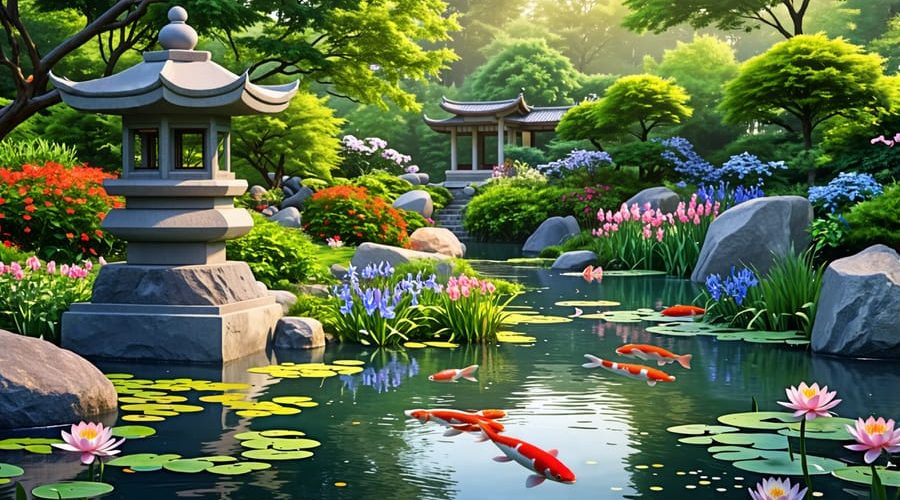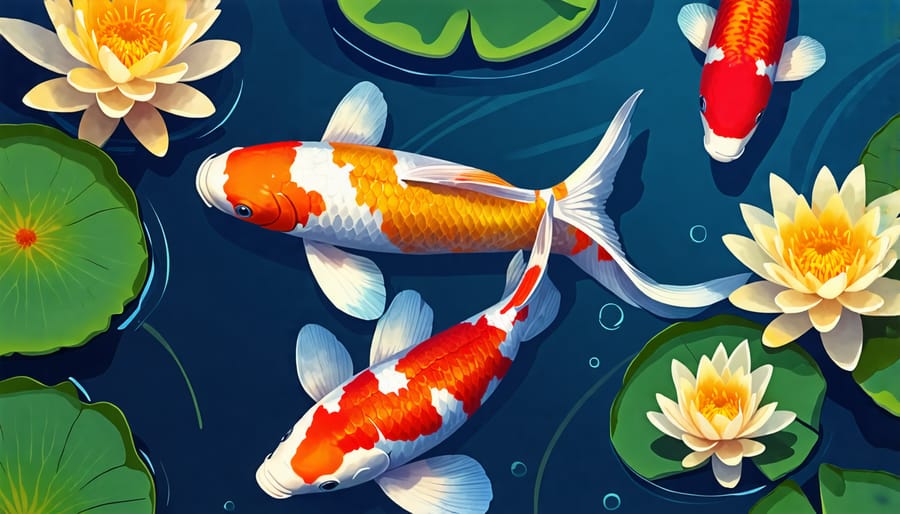
7 Secrets to Crafting a Serene Japanese-Style Pond in Your Backyard
Embark on a tranquil journey into the heart of Japanese pond design, where harmony, balance, and serenity intertwine to create an enchanting aquatic sanctuary. In this article, we delve into the ancient art of crafting Japanese-style ponds, unearthing the secrets that have captivated generations with their timeless beauty and profound symbolism.
Discover the core aesthetic principles that underpin the essence of Japanese pond design, from the delicate interplay of water, stone, and vegetation to the masterful incorporation of asymmetry, simplicity, and natural elements. Unravel the mysteries behind iconic design features such as koi fish, stone lanterns, and arched bridges, and learn how each component contributes to the overall composition’s breathtaking allure.
Immerse yourself in the world of aquatic plants, as we explore the diverse palette of flora that breathes life into these serene oases. From the graceful sway of irises and lotus blossoms to the lush foliage of water lilies and rushes, discover how to artfully arrange vegetation to create a harmonious tapestry of color, texture, and movement.
Embark on a journey of self-discovery as you learn to cultivate your own Japanese-inspired pond, transforming your backyard into a tranquil retreat that nourishes the soul and soothes the senses. With expert guidance on design, installation, and maintenance, you’ll be empowered to craft a living work of art that reflects the timeless wisdom and beauty of Japanese pond design.
Embracing Simplicity and Asymmetry

Less is More
In Japanese pond design, embracing simplicity is key. Resist the urge to overcrowd your pond with too many elements. Instead, let the beauty of water, stone, and carefully selected plants shine through. Leave ample open space around your pond, allowing the eye to rest and appreciate the tranquility. A clutter-free approach not only enhances the visual appeal but also creates a sense of harmony and balance.
When placing rocks, plants, and other features, be intentional and minimal. Each element should serve a purpose and contribute to the overall composition without overwhelming the space. Remember, the goal is to create a serene and meditative atmosphere where less truly is more. Embrace the concept of “ma,” the Japanese principle of negative space, to let the pond breathe and evoke a feeling of calm and reflection.
Breaking Perfect Symmetry
While perfect symmetry may be pleasing to the eye, Japanese pond design embraces the beauty of asymmetrical balance and irregular shapes. Instead of mirroring elements on both sides, asymmetry creates a more natural and dynamic aesthetic. Incorporate curved shorelines, strategically placed boulders, and organic island formations to break up the pond’s geometry. This approach not only adds visual interest but also mimics the imperfect charm found in nature.
When selecting stones and decorative elements, opt for varied sizes and shapes to enhance the asymmetrical balance. Position larger rocks off-center and use smaller stones to create meandering pathways or secluded seating areas. Embrace the unique character of each element and let their irregularities contribute to the overall design. By breaking away from rigid symmetry, your Japanese-inspired pond will exude a sense of tranquility and organic flow that invites peaceful contemplation.
Selecting Symbolic Elements
Arranging Rocks
Rocks play a crucial role in the aesthetics and functionality of a Japanese pond. When selecting rocks, opt for natural, weathered stones with interesting shapes and textures. Granite, limestone, and river rocks are popular choices. Avoid using rocks with sharp edges or artificial materials.
Placement is key to creating a harmonious and natural look. Position larger rocks first, ensuring they are firmly set and partially submerged. Arrange them in odd-numbered groupings for visual appeal. Use smaller rocks to fill gaps and create a sense of continuity. Experiment with different configurations until you achieve a balanced and pleasing composition.
Consider creating “islands” within your pond using rocks. These features add visual interest and provide perches for birds or basking spots for turtles. To construct an island, carefully stack and arrange rocks to form a stable base. Fill the center with soil, and plant moisture-loving vegetation to soften the appearance and integrate the island seamlessly into the pond.
Remember, the placement of rocks should mimic natural formations found in nature. Avoid overly symmetrical or uniform arrangements. Allow the rocks to tell a story and guide the viewer’s eye through the pond. With thoughtful rock selection and placement, your Japanese pond will exude tranquility and balance.
Incorporating Stone Lanterns and Basins
Stone lanterns and basins are quintessential elements in Japanese pond design that add a timeless charm and soft illumination to your water garden. When positioning these features, consider the overall balance and harmony of your pond layout. Place stone lanterns near the water’s edge or on an island, ensuring they are stable and level. Opt for classic styles like the Yukimi (snow-viewing) or Tachi (pedestal) lanterns, which complement the natural surroundings with their simple elegance.
To create a mesmerizing ambiance, choose lanterns with intricate cut-out patterns that allow light to dance across the water’s surface. Soft lighting from candles or LED lights placed inside the lanterns will cast a warm, inviting glow, transforming your pond into an enchanting oasis after sunset. Incorporating Stone Lanterns and Basins alongside your pond will not only provide a visual focal point but also create a serene and meditative atmosphere.
Stone basins, or tsukubai, are another essential element in Japanese pond design. These low-lying basins are traditionally used for washing hands before tea ceremonies, but in a pond setting, they serve as a decorative water source and a symbol of purity. Position the basin near the pond’s edge or along a meandering path, encouraging visitors to pause and appreciate the tranquil beauty of your water garden.


Nurturing Living Elements
Harmonious Aquatic Plants
When designing a Japanese-style pond, selecting the right aquatic plants is crucial for creating a harmonious and balanced ecosystem. Consider including graceful water lilies, whose floating leaves and vibrant blooms add visual interest while providing shade for fish. Lotus plants, with their majestic flowers and distinctive seedpods, are another iconic choice that symbolizes purity and enlightenment in Japanese culture. Submerged plants like hornwort and water lettuce help maintain water clarity by absorbing excess nutrients. Along the pond’s edges, incorporate marginal plants such as iris, rush, and cattails to soften the transition between water and land. When arranging your Harmonious Aquatic Plants, consider their mature size, growth habits, and seasonal changes to ensure a visually appealing and well-balanced display throughout the year. With thoughtful selection and placement, your Japanese pond will come alive with the tranquil beauty of nature.
Introducing Koi Fish
Koi fish are a stunning addition to any Japanese-style pond, renowned for their vibrant colors, graceful movements, and calming presence. These elegant creatures not only enhance the visual appeal of your pond but also offer a serene and meditative element to your outdoor space. Introducing Koi Fish to your pond requires proper care and attention to ensure their health and longevity. Koi are hardy fish, but they do have specific needs when it comes to water quality, diet, and living space. To keep your koi thriving, maintain a clean and well-oxygenated pond with proper filtration. Feed them a balanced diet of high-quality koi food, and supplement with occasional treats like lettuce, peas, or watermelon. Avoid overfeeding, as this can lead to health issues and poor water quality. With the right care and attention, your koi will bring years of beauty and tranquility to your Japanese-inspired pond.
Mastering the Art of Maintenance
Balancing Water Quality
Maintaining crystal-clear water is essential for the health and beauty of your Japanese pond. To achieve this, employ a combination of filtration systems, skimmers, and regular cleaning practices. Choose a filter that suits your pond’s size and fish population, such as a submersible or external filter, to remove debris and harmful pollutants. Skimmers, placed at the water’s surface, help capture floating leaves and other organic matter before they sink and decompose. Establish a consistent cleaning routine, which includes removing accumulated debris, checking filter media, and performing partial water changes. Avoid using harsh chemicals that can disrupt the delicate ecosystem. Instead, opt for natural methods like barley straw, which slowly releases hydrogen peroxide to control algae growth. Regularly test the water parameters and make necessary adjustments to maintain a balanced environment. By dedicating time to these maintenance tasks, you’ll ensure your Japanese pond remains a tranquil and thriving oasis.
Pruning and Caring for Plants
Pruning and caring for the plants in your Japanese pond is essential for maintaining a healthy and visually appealing water garden. Throughout the seasons, remove any dead foliage or spent flowers to keep the pond looking tidy and prevent decay from affecting water quality. In spring, divide and repot overgrown marginal plants to encourage vigorous growth and prevent crowding. Propagate favorite plants by taking cuttings or dividing rhizomes, ensuring you always have a supply of lush greenery.
As temperatures drop in autumn, trim back dying foliage and remove floating plants to prepare for winter dormancy. Hardy marginals can remain in the pond, but tender varieties may need to be overwintered indoors or in a greenhouse. With attentive seasonal care and a passion for nurturing your aquatic plants, you’ll be rewarded with a thriving, balanced ecosystem that enhances the tranquil beauty of your Japanese-inspired pond retreat.
Conclusion
In conclusion, Japanese pond design offers a captivating blend of natural beauty, tranquility, and artistic expression. By incorporating key elements such as strategic placement, harmonious stone and plant selection, and the gentle presence of koi fish, you can create your own enchanting backyard oasis. Remember, the essence of Japanese pond design lies in its simplicity, balance, and ability to evoke a sense of serenity.
As you embark on your pond-building journey, embrace the process as a meditative and rewarding experience. With patience, attention to detail, and a willingness to let nature guide your design, you can craft a space that not only enhances your outdoor aesthetics but also provides a soothing retreat from the stresses of daily life.
The benefits of having a Japanese-inspired pond extend far beyond mere visual appeal. It offers a sanctuary for wildlife, a place for quiet contemplation, and an opportunity to connect with the rhythms of nature. As you nurture your pond and watch it evolve through the seasons, you’ll find yourself more attuned to the subtle beauty that surrounds us.
So, whether you’re a seasoned water gardener or a curious beginner, embrace the art of Japanese pond design and unlock the transformative power it holds. With each mindful step, you’ll be one step closer to creating your own piece of paradise right in your backyard.
